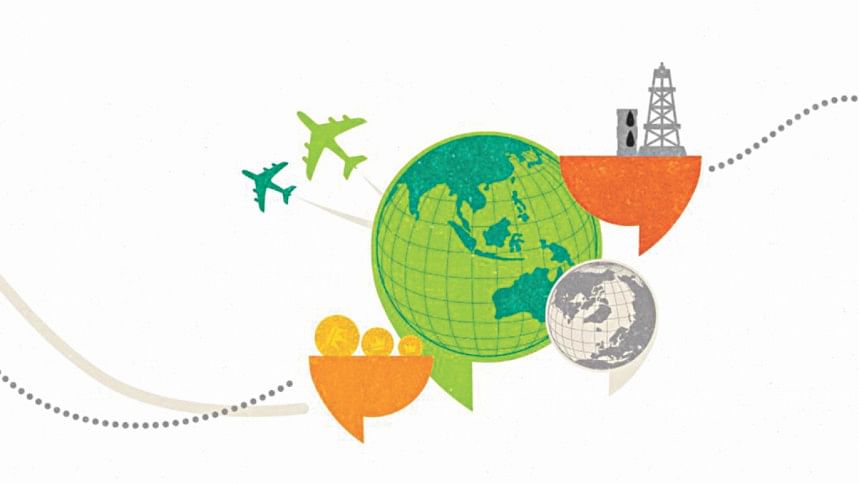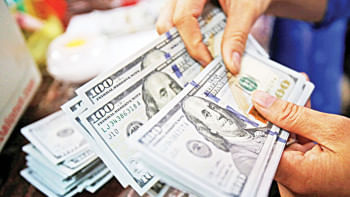Living and growing with the "new normal"

If the first month of 2016 is an indication of things to come, then the only certainty in 2016 is that there will be high uncertainty. Plunging oil prices, the double whammy of slowdown in the emerging markets, especially the BRICS countries and the continuing financial and political malaise in the advanced economies particularly Europe, climate change and the new norm of lower "sustainable" growth driven by domestic consumption in China - in an over connected world all of these factors are not only coming together to influence global trade, investment flows and markets but casting a long shadow reaching also Bangladesh.
"Global trade, which was already growing slowly over the past few years, appears to have stagnated," said Angel Gurría, the OECD's secretary general, presenting its latest economic forecasts and predicting trade growth of around 2% this year. "What happened in the past 50 years whenever there was such a slowdown in trade growth, it was a harbinger of a very sharp turn of the economy for the worse."
The global economy has always had different sources of growth helping to compensate for the laggards such as the emerging markets when Japan and USA were low, or China when the global financial crisis erupted. But today we are in a unique situation where it is very hard to identify a MAJOR source of economic activity that can lift the world out of its current economic malaise. India has recently emerged as the fastest growing economy in the world but there are enough serious naysayers even in India , for us to not being able to depend on India being able to do all the heavy lifting on it's own.
But then why is this all relevant for our own Bangladesh economy which ,as many politicians, development partners, think tanks and trade body leaders, will tell you has been on a sustained economic growth trajectory of 6%+ over the last decade and with some forecasts for even higher this year?
The reason I believe it is relevant is that if we are ABLE to factor in these conditions and make the course corrections WE believe are needed in policy and implementation - we can do EXACTLY that, we can continue to beat the curve. Bangladesh CAN be one of the outlier economies in 2016 in terms of growth but it will not happen through wishful thinking or business as usual. The world changed from 2014 to 2015 and is doing so already in 2016and we need to respond.

The first fact is that despite all the talk about export diversification in terms of products and markets, Bangladesh remains still very much a one trick pony, with more than 80% of our export earnings coming from RMG and Textiles and more than 80% of our exportables destined for USA, EU and Japan. But globally, consumers are spending less. Global expenditure on clothing and footwear is expected to decline by 1.5% in US dollar terms in 2015 to its lowest level since 2011, according to a report in the latest issue of Global Apparel Markets from the business information company Textiles Intelligence
The decline was due largely to depreciations of the currencies in a number of major supplying countries against the US dollar. Such depreciations have made exports from these countries cheaper in US dollar terms and this has made suppliers from these countries more competitive viz-a-viz Bangladesh.
In China, for instance, the value of the renminbi fell against the US dollar by 4% between October 2014 and October 2015 after a sustained appreciation between July 2005 and October 2014. In January 2016 the Yuan touched a five year low against the USD.
As a result, buyers who source from China are able to negotiate reduced prices. Chinese producers may also further reduce their prices in order to remain competitive with their counterparts in Vietnam, given that the latter are set to gain from preferential access to the US market under the impending Trans-Pacific Partnership (TPP) agreement.
During 2008-09 global financial meltdown, India witnessed decline in exports for nine months in a row. This time in 2015 it has been for 11 consecutive months. (Source : GLOBAL SLOWDOWN HURTING INDIA'S TARGET, NOVEMBER 24, 2015 By K R Sudhaman)
In India, the rupee depreciated by 13% against the US dollar between 2012 and 2014. During the first nine months of 2015, it was down by 4% compared with the corresponding period a year earlier to its weakest level on record.
The depreciation of the rupee has made Indian products cheaper in US dollar terms and therefore more attractive to foreign buyers.

India's grim exports scenario this financial year prompted their government to respond by announcing three per cent interest subsidy. With India's exports declining for the eleventh month running in October 2015 and no immediate recovery visible in the near future, the government decided to give a leg up to the declining exports by announcing the interest subsidy for five years providing much head room for exporters to plan their strategy. This cheaper credit under the interest equalisation scheme, approved by the cabinet committee on economic affairs will be available from April one this year for both pre and post shipment rupee export credit.
"The decline in exports is worse than even that during the global slowdown. With this, reaching even USD300 billion of exports this year looks difficult," said Ajay Sahai, director-general of the Federation of Indian Export Organisations.
The EURO depreciated against the US dollar by a sharp 18% in the first nine months of 2015. Exchange rate fluctuations represent one of a number of factors weighed on the global economy in the first half of 2015. Other factors include: a slowdown in demand for imports in China and a number of other emerging markets; and low prices of oil and a number of other commodities, including cotton. Furthermore, growth in goods trade in the coming months could be hampered by a sharper than expected slowdown in economic growth in developing economies, flat real wage growth and more interest rate rises in the USA, and unanticipated costs associated with the migration crisis in Europe.
So in 2016 Bangladeshi exporters of RMG, textile products and other products will face serious price pressures from their buyers in their traditional markets in Europe and USA to maintain share let alone grow share. Since a major component of our economic growth is export growth, this will need to be addressed.
Another important factor affecting exports that is hardly mentioned is the effect of weather on retail sales in developed markets like USA and EU. 2015 has been the hottest year on record since we started keeping records thanks to El Nino and 2016 is predicted to be more of the same, if not worse. Sales of apparel and footwear are directly affected by weather and poor winter sales in 2015 have led to high inventory build up already amongst retailers which reduce their need and budget to buy more products for the next winter season. And winter season shipments are traditionally higher value and more important for our exporters, be it sweaters, handicrafts or shrimps.

Exports as the main growth driver in Bangladesh till today face serious obstacles to growth due to the loss of competitiveness viz-a-viz competitor nations, warm and late winter in Europe and USA, and depressed global demand.
Remittances are a second growth driver in Bangladesh after exports, and plunging oil prices have already led to unprecedented austerity measures in our major remittance source countries like Saudi Arabia and Kuwait. We have seen a slowdown in remittance growth from these traditional source countries and we will need to develop a strategy to overcome further declines, if this trend continues . With no end in sight of plentiful supply of oil against slowing demand, the forecast is that oil prices will continue to remain depressed in the short and medium term . So we need to prepare our strategy of how to protect and drive remittances growth not just in gross terms but also in per capita terms.
Domestic consumptionin Bangladesh is a third growth driver and countries such as Indonesia and Brazil were both able to ride out the previous crises thanks to their strong domestic market power. In 2015 however we have seen that despite wallet size remaining unchanged, many consumers in Bangladesh have down traded on their purchase decisions, opting for lower cost options for example for FMCG items. Low rice prices despite being a populist favourite and benefiting the urban vocal consumers have meant that spending growth in the rural economy has also been depressed. Services already are the largest employer in our economy and this is one area where demand remains strong but growth has also slowed down. Manufacturing has been constrained by slowing demand, rising costs, high interest rates, infrastructural deficits, irrational land prices and increasing difficulty of doing business in general caused by excessive bureaucracy, frequent policy changes and poor governance.
I believe that every single farmer, worker, employee, employer, manager, entrepreneur and business in Bangladesh who fight against these odds each and every day to deliver food, products and services for our nation of over 160 million, deserves better. And so I have prepared a wish list for ten do-able actions, which if done or at least started, could help Bangladesh beat the odds:
1. Phased and systematic decentralisation of power from Dhaka to the district levels for with the Honourable Members of Parliament being given more authority and also being held accountable for delivering sustainable economic growth in their areas. China did this with their provinces through out the 1990s, and India is doing it with their states in 2016 as Bengal and Karnataka for example compete with each other to attract investment . As long as businesses ALL need to run to Dhaka for each and every permit and utility connection, we cannot accelerate growth.
2. Deployat least USD1 billion fromour record high foreign exchange reserves strategically to off shore units of our local banks so that they have access to low cost funds, which they can relend to local businesses at low single digit rates of interest. The Government must continue to DRIVE down bank interest rates as it has started doing so effectively in the second half of 2015, as interest rates in Bangladesh are notoriously "sticky " downwards .
3. Pass through some of the savings achieved from the record low oil import prices to end consumers of diesel and petrol so that they have increased spending power and savings.
4. Benchmark our REER ( real effective exchange rate) against some key competitor nations such as India, China and Vietnam so that we do NOT lose export competitiveness.
5. Enable citizen and business participation on monitoring bodies overseeing implementation of major ONGOING infrastructural projects such as Dhaka- Chittagong multi lane high way and also proposed Deep Sea port project. These can directly improve our LEAD times for exports and also reduce costs on imports. Today the freight price of a 40 ft container from Genoa to Shanghai is USD 40; from Genoa to Bangladesh is over USD 1000!
6. Reduce the number of projects adopted under ADP but focus on quality and implementation and work with local actors such as local government and proven citizens groups and NGOs to monitor implementation. This can boost spending in the local economy.
7. Identify labourintensive, high value adding industries like light engineering, agro processing, and import substituting industries such as pharmaceuticals and create long term supportive policy framework .
8. Target specific FDI sourcing countries such as Japan, China, India and Germany and engage experts with proven experience from each of these countries to map out what strategies we need to bring in FDI from them. Complete with targets, budgets and incentives required.
9. Revamp Dhaka airport - right from the immigration the experience is investor unfriendly. Need to allow internationally proven airport operators to manage the airport so that the entire experience of using Dhaka airport can be as painless and as efficient as possible. Special emphasis needs to be on immigration services, baggage handling, airfreight logistics. Bangladesh can seriously explore a visa free regime for many friendly nations as India has recently announced.
10. Cultivate and ensure a culture of tolerance and inclusiveness where despite diversity of views, we can agree on fundamental values and principles as Bangladeshis. We have to continue to work towards building a more equitable and prosperous society for all Bangladeshis, based on the rule of law, especially for those without voice.
I take as much pride as anyone elsein the resilience of our people - of how despite untold natural and some manmade disasters - we continue to power forward and overcome each obstacle. But I would submit in conclusion, we owe it to ourselves to not always need to be so resilient.
Bangladesh has come very far since our birth in 1971. We have much to be proud of already. But as humans we all aspire for better, easier, happier lives. And when people ask me how I think we will get there I repeat the Tenacity Prayer of Ray Kroc :
"Nothing in the world can take the place of Persistence.
Talent will not; nothing is more common than unsuccessful men with talent.
Genius will not; unrewarded genius is almost a proverb.
Education will not; the world is full of educated derelicts.
Persistence and determination alone are omnipotent."
The writer is managing director, Apex Footwear and president, MCCI.

 For all latest news, follow The Daily Star's Google News channel.
For all latest news, follow The Daily Star's Google News channel. 



Comments